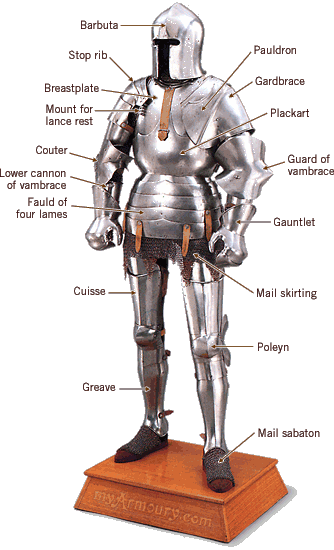
 |
|
|
Anatomy of Armour: Gothic Armour of the 15th Century
An Article by Nathan Robinson  Milanese Armour, belonging to a member of the Von Matsch family of Castle Churburg
Milanese Armour, belonging to a member of the Von Matsch family of Castle ChurburgSchloss Churburg, circa 1455 Glasgow Art Gallery and Museum, Kelvingrove This armour was almost certainly owned by a member of the Matsch family of Castle Churburg in the Italian Tyrol. Churburg now belongs to the Trapp family, successors of the Matsches in an unbroken sequence since the Middle Ages, and still houses the armours of the two families. The harness shown here now resides in Glasgow and is unique in Britian. Having left Churburg as recently as the 1930s, its pedigree is precisely known. The condition of this Italian armour is remarkable considering it is over five centuries old. Even more impressive is the fact that this harness is very nearly homogeneous. While the right gauntlet is genuine, the left one is of modern manufacture, made to match. The helmet, a Barbuta, is contemporary to the armour and though it does not belong, it is a fine piece in itself; still retaining much of its original padded lining. The mail shirt is also not original, for during this time it was becoming less common to wear a complete mail shirt under plate armour. Rather, smaller mail gussets were sewn into the arming doublet to protect areas not fully covered by the plate. Some sections are also missing. Most notably, the four leather straps seen hanging from the front would have held two plates, called tassets, to protect the vulnerable areas between the body and legs. Similarly, plates are missing from the back. A reinforce, or strengthening piece, would have been attached to the right pauldron but instead shows evidence of being wrenched off, possibly in action. Other signs of use are dents and damage to the two lower front portions of the fauld, or skirt, which may be a result of an impact by crossbow bolt or lance. The general form of this armour, with its smooth round shapes and subtle curves, follows a common style developed in Italy during the 15th century. The rounded, simple lines suggest a utilitarian and robust appearance while imparting an understated elegance to its strength of form. The leftmost side is more heavily protected, enhancing the metaphor of durability. The Italian fashion also dictated the use of mail rather than plate sabatons to protect the feet. The reputation of Italian armourers was such that their products were in demand all over Europe. A vast export trade was built up, while Italian styles commanded wide influence. Only in southern Germany and in Austria were there comparable centers of armour manufacture during this particular period of time.  Late German Gothic Armour of the
Late German Gothic Armour of theArchduke Sigmund (1427-96) Lorenz Helmschmid, Augsburg, circa 1480 Waffensammlung, Vienna Finding 15th century homogeneous suits of German armour certainly isn't an easy task. Nearly every displayed harness is a composite, comprising of various pieces of similar styling. One nearly complete example found in the Historisches Museum, Vienna, unfortunately lacking its helmet and vambraces, dates from the decade beginning 1450. Otherwise only individual parts, particularly helmets, from complete knightly armours have been handed down from the beginning of the German late gothic period in the late 15th century. Shown here is a most excellently preserved early German cuirass, as the complete armour was called. It is undoubtedly that of the Archduke Sigmund. Maximillian I (1459-1519) probably used it himself when he was a young prince and presumably presented it to his uncle Sigmund, who succeeded him in 1490 as Lord of the Tyrol, part of the Hapsburg Empire. In 1484 Duke Sigmund of Tyrol (1427-1496) married Katherina of Saxony. The bridegroom received this cuirass made by Lorenz Helmschmid as an Imperial gift for the occasion. Augsburg had become a center for the manufacture of ceremonial armour, and Helmschmid was the preferred armourer of the Emperors Frederick III and Maximilian I, the self-styled "Last of the Knights". This German armour clearly differs from the Milanese armour, presented above. Following Burgundian fashion, the proportions are slender with an extenuated narrow waist and are characterized by pointed shapes and fluted parallel lines. The sallet, a form of helmet, protects the head. The bright surfaces are edged with gilded ornamental bands patterned with lilies. This work, defined by the rippling of angular lines and sharp ridges, reveals the German's special talent for line and the graphic, contrasting the Italian armourer's preference for large and simple sculptured forms. The armour possesses marked flexibility and did not unduly burden the prince, a man of small stature. It weighed only the usual forty pounds or so, which were fairly evenly distributed over the entire body. A hinged lance rest facilitated the rider's handling of the long equestrian lance. The bizarre pointed sabatons had their origin in a peculiar whim of fashion of the period. As they were only meant to be worn on horseback, the points could be removed when the rider wished to go on foot. About the Author Nathan Robinson has been interested in history and the hobby of reproduction arms and armour collecting for well over a decade. A professional Web developer in San Francisco, he started myArmoury.com as a resource for like-minded people and hopes to help educate and entertain enthusiasts and consumers alike. He strives to push the sword community forward, helping create a healthy market with functional and historically-researched pieces available for us all. Acknowledgements Photographs copyrighted by The Scott Collection, Glasgow and The Kunsthistorisches Museum, Vienna |
|